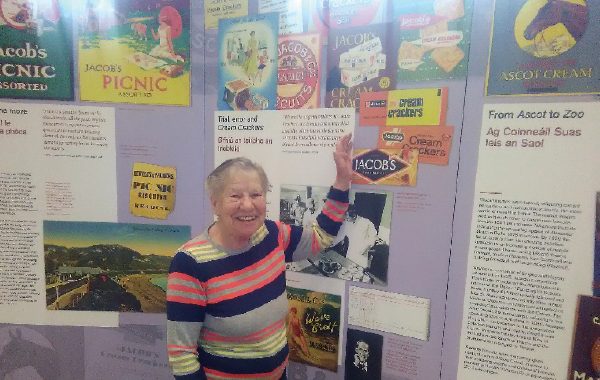
Ailish Byrne, daughter of Jacob’s worker Florence O’Connor at the exhibition.
Photo by Paul O’Rourke.
September and October saw an interesting exhibition on the history of Jacob’s biscuit factory in residence at Pearse Street library.
The tour was presented by curator Wendy Williams and kicked off with some details on how the famous Irish biscuiteers were formed back in 1850. Robert and William Jacob were brothers who inherited their father’s Waterford-based bakery business, which at the time was making bread, barm and ship biscuits (which were described as boringly hard and sugarless.)
The brothers took a sweet leap of faith and began branching out into the ‘fancy’ biscuit market, within one year producing fifteen different varieties, and soon after that, commenced exporting to the U.K. They also moved to Dublin and opened a premises on Bishop street, where the Dublin Institute of Technology now resides.
1880 saw a major setback, with a spectacular fire that destroyed the factory (apparently large quantities of flour can be explosive), but Jacob’s soon recovered and by the end of the century were exporting to such far-flung places as Athens, Calcutta, and the Philippines. In 1912 the brothers opened their second factory in Liverpool, and by the 1920’s they were employing 3,000 workers, two thirds of whom were women.
1913 saw the Dublin operation affected by the Lockout strike of that year, with management having to bring in staff from the UK to fill roles vacated by striking workers. Jim Larkin referred to the Jacob’s board as slave drivers but they subsequently took him to court and won. Despite this vindication, staff were subjected to the indignity of interviewing to get their old jobs back when it was all over.
The factory also had a special role to play in the 1916 Rising (or should that be the self-rising!) when it was selected by Thomas McDonagh as a building of strategic importance, due to its substantial height.
With Jacob’s being a strong unionist firm, workers were encouraged to enlist in the British efforts during the First World War, 650 did and 57 died. But, as they say, war is a profitable business, and at its height, Jacob’s were exporting 1.2 million packets of biscuits to the front each week.
Other interesting wartime facts were the introduction of the USA assorted range to celebrate the entry of American troops into battle and the company’s donation of one of their delivery trucks and driver to bolster the Red Cross fleet of ambulances.
Jacob’s, of course, were also famous for looking after their workers, something that began with one the brothers visiting the Heinz factory in Pittsburgh on a fact-finding mission. On his return, a swimming pool was built for the Dublin staff, a subsidised cafe was opened for men, and then women, and a doctor and dentist were provided on site with medicine available at reduced prices.
A sports ground was built in Dolphins Barn, in fact Jacobs’ football team helped form the League of Ireland and day trips proved especially popular, with the company leasing the Isle of Man ferry on a bank holiday Monday for the annual worker and family outing.
Not surprisingly, Jacob’s became a much sought-after place to gain employment, with sometimes five generations of the same family plying their trade there.
By the 1930’s Jacob’s had over 300 lines of biscuits and over 4,000 workers. Among those workers was Florence O’Connor from Charlemont Street, who was employed at the biscuit factory from 1925 to 1935, having to leave when she got married. Her daughter, Ailish Byrne, was on the tour we attended, and fondly remembered that time in her house and especially the Jacobs’ Christmas pantomimes.
The next big event in the company’s timeline was the launch and relaunch of the one and only, Cream Cracker. Originally named the Wave Crest, the first incarnation of the flaky favourite was a flop, but then the recipe was changed, more fat was added, and hey presto, the Cream Cracker was born and catapulted into culinary cultdom.
1961 saw the launch of RTE, and with that Jacob’s spotted an opportunity to extend the reach of its brand. They sponsored the TV awards from 1962, a sponsorship that would continue for the next 38 years.
In 1968 the brand launched the first teaser for their famous Fig Rolls campaign. An advert was taken out on the back page of national newspapers which simply read ‘Jim Figgerty come home, all is forgiven.’
This, of course, caused people to chatter and speculate as to who Jim Figgerty was and to where he had absconded. Prayers were said at mass, sightings were reported as far away as the Aran Islands, and Jacob’s themselves were getting up to 1,500 phone calls per day to their offices from curious customers.
Figgerty was, it was later revealed, the only man with the secret recipe revealing how to get the figs into the fig rolls. He was eventually captured by the mythical Figmes of Figeria and safely returned to the fig factory on Bishop Street.
The success of Jacob’s continues until this day, although it is perhaps not as influential as it once was in Irish society. Even so, people are still scratching their heads and wondering, just how do they the get those figs…
by Paul O’Rourke.



